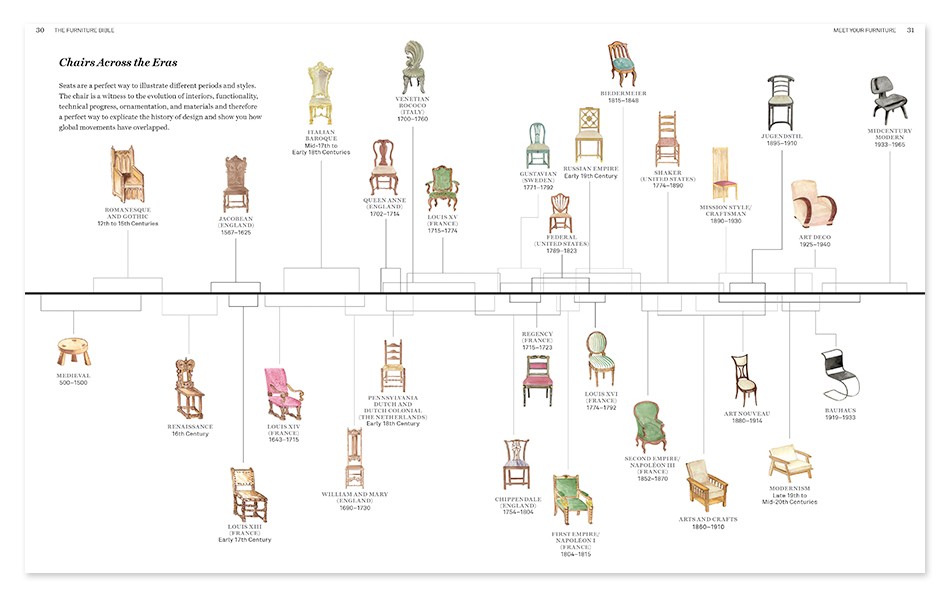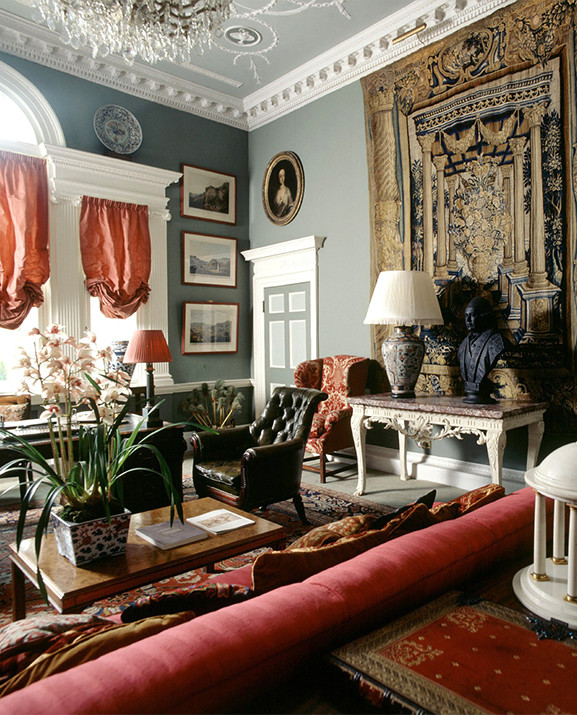
January 12, 2015Christophe Pourny’s new book offers a definitive guide to caring for furniture. Top: The French-born, New York–based restorer. All photos by James Wade, and all images excerpted from The Furniture Bible by Christophe Pourny and Jen Renzi (Artisan Books), copyright © 2014
After some serious deliberation, that antique mirror or credenza that once lived in your “My Favorites” folder on 1stdibs is finally sitting in your living room. Now what? As its new guardian, how do you ensure that this perfectly preserved artifact from an earlier era will remain in pristine condition for another 100 years — and beyond?
“Do as little as possible,” says New York expert furniture restorer Christophe Pourny. “High-quality antiques are so well-made they actually require very little upkeep.”
The worse damage you can inflict on an antique can be from over-attention: too much polishing, too much scrubbing and too many cleanings, Pourny explains. (It’s akin to over-watering your houseplants.) That’s not to say your antique should be ignored, he quickly adds, and regularly taking note of the piece’s condition — whether the wood seems dry or the paint is showing a hint of flake — is the most important thing you can do.
Such sage, yet digestible, advice now fills the pages of Pourny’s new publication, The Furniture Bible (Artisan Books; $35), which he co-wrote with 1stdibs contributor Jen Renzi. Pourny describes it as a coffee table book crossed with a how-to manual for collectors, DIY enthusiasts or just anyone who appreciates design. As he sees it, The Furniture Bible offers an informative but more approachable alternative to esoteric guides on restoring furniture and encyclopedic tomes on styles and terms. “People are very intimidated by antiques,” Pourny says, “I hope this helps to make them more accessible.”

Pourny works out of a studio in Brooklyn’s Industry City, a waterfront area in the Sunset Park neighborhood that’s being developed as a center for manufacturers, artisans and designers.
Accessible but still entirely erudite, the book begins with “Meet Your Furniture,” a concise overview of furniture styles from medieval times through mid-century modernism, with clever sidebars that identify, say, 17 different types of chaise longues, as well as a mini-guide on how to distinguish the four Louis styles based on leg adornments. Other chapters do a deep-dive into wood types, hardware and materials, offering definitions and advice on care (never clean tortoiseshell with water). There’s also a section on finishes — which Pourny calls his “personal passion” — and everything anyone might want to know about waxing, lacquering, stripping, staining, ebonizing and much more. Tips range from professional (how to make your own glaze) to do-it-yourself (nicked a chair leg with the vacuum? Try rubbing the spot with a piece of walnut; the oil should fill in the scratch). These are the same clever morsels he shares with such frequent clients as Martha Stewart, who penned the book’s foreword, Uma Thurman and Bunny Williams, one of many top decorators with whom Pourny works.
Now based in Brooklyn, where he lives, he admits, surrounded by spare, modern furniture – “I have an intense enough relationship with antiques that I don’t need to come home to them every night,” he says — Pourny grew up in Fayence, France, where his father ran an antiques store full of pieces he bought at estate sales and then restored. After studying history at the University in Nice, Pourny was drawn back to the family business and apprenticed himself to his uncle, the renowned antiques dealer Pierre Madel, and learned the trade working in his Paris atelier on Rue Jacob. He moved to New York in the 1990s and today serves as the city’s official restorer, working on the antiques that fill City Hall and Gracie Mansion.
Although he works at an incredibly high level, Pourny himself comes across as warm, funny and wise. For instance, he writes that you should educate your eye by browsing high-end antiques shops, but you should not “roll your eyes and say ‘Yikes!’ if the price of an item is high.” He’s something like The Goldfinch’s restorer extraordinaire Hobie Blackwell come to life – if Hobie were a handsome Frenchman who admitted to having “majorly scored during impromptu Dumpster-diving sessions!” Below, Pourny offers additional astute advice on how to take care of several different types of antiques frequently found on 1stdibs.
Curious to know more? Email your question about identifying, maintaining or restoring a piece of furniture to editorial@1stdibs.com and Pourny may answer it in an upcoming column!
Georgian Table
This rustic and informal table has a deeply burnished finish that’s the result of years of use and abuse. For this type of table, the existing finish is usually wax. Over time, wax dries out and loses its shine and protective properties. The table should be dusted regularly with a dry, clean wool or felt rag, and then re-waxed once a year and buffed to a new shine.
Common Problems: First, there is the use of cleaning products like Pledge, which will seep through the wax, gunk up the surface and eventually require drastic refinishing. Water and other liquid rings are common on wax finishes. Wiping off the liquid right away will prevent any damage, and rings can be removed by re-waxing the wood with a clean rag. If the damage persists, rub it with tung oil or boiled linseed oil — now readily available — let it dry, and re-wax.
Gustavian Desk
The painted and distressed finish on this desk will require minimal care. Once a year, apply a coat of natural polish. Avoid chemicals and use only pure tung oil or boiled linseed oil. Apply liberally, wait a few minutes, then wipe off carefully, and let dry overnight before using or putting things on it. Do this once or twice a year at most.
Common Problems: Paint flaking and gunk or dirt accumulating on the paint and staining it. Paint is a good protection, but old paint is chemically less resistant by nature. The tung- or boiled linseed-oil polish used for regular care can be used topically as a cleaning agent, rubbing a rag on the problem. If the damage resists, a Q-tip dipped in pure gum turpentine and rubbed on the spot is the next step. In both cases, clean and wipe off after application with a dry, clean rag. Don’t forget to dispose of rags carefully by saturating them with water.
Ormolu Candelabra
Call Liberace! I chose this item to warn against any over-cleaning and polishing; gilt ormolu should only be dusted with a clean, dry rag. Use a soft brush to get rid of dirt accumulating in details and ornate parts. Tarnished areas are the result of the gilding wearing off and should not be polished with brass polish as it will only rub off the surrounding gilt. Gilt wearing off is natural and a sign of age. Of course, you should never have antique ormolu re-plated!
Common Problems: Any dirt resisting dusting and a soft brush can be addressed with a soft toothbrush dipped in soapy water to loosen the caked grime. Use natural soap, such as Marseille or Castile, rinse with a damp rag, and dry carefully.
Hans Wegner Chairs
The wood on these chairs will just need dusting and a yearly polishing with boiled linseed or tung oil. The leather should be treated with a leather cream, not a shoe polish, that’s clear or natural in color. Never use colored leather polishes.
Common Problems: End of the legs banged and nicked, drying finish, distressed leather, loose joints. The legs can be refreshed with clear wax to remove nicks and scratches. You can always think about taking off the leather seat and back, which are very removable on modern seating. Stains on leather should always be left to professionals. Loose joints should be addressed as soon as noticed, so as not to damage the joinery any further — the first step is swelling the joint parts with water or wood-sweller products found in fine woodworking catalogs. If you have to re-glue, use only hide glue or white glue, traditionally used in joinery — never epoxy or cement glues, as they are irreversible and stronger than the wood, so they will eventually tear it apart.
Rosewood Credenza
Such pieces were usually finished with hand-rubbed polishing oils. Care should be limited to dusting and an occasional brisk buff with a wool or felt rag.
Common Problems: Light finishes mean stains and scratches. Color-wise, scratches can be remedied by using wood-wax crayons or colored shoe polish in the appropriate hue. A good waxing and buffing to a new shine should take care of the dryness and blemishes. Consider keeping rosewood, teak, mahogany, walnut and all medium and dark wood usually used by mid-century cabinetmakers away from sun and extreme light, which will discolor and fade them rapidly.
Giltwood Mirror
Dusting with a rag is not recommended for gold-leafed items, as they can catch fragile gilding and repeated friction will wear off the gold. Clean only with a feather duster, and never use any products.
Common Problems: Dirt build-up or flaking of the gold. Keep all gilded wood items away from sources of heat (such as radiators), and try to maintain an even indoor climate through humid summers and dry, cold winters. For heavy dust on the finish, lightly pass a damp cloth over the surface. Any serious damage should be left to a professional. In any case, never use gold paint to touch up the damage; removing it to restore a gilding would be almost impossible.













